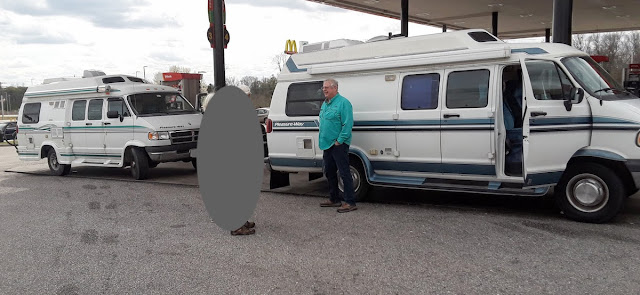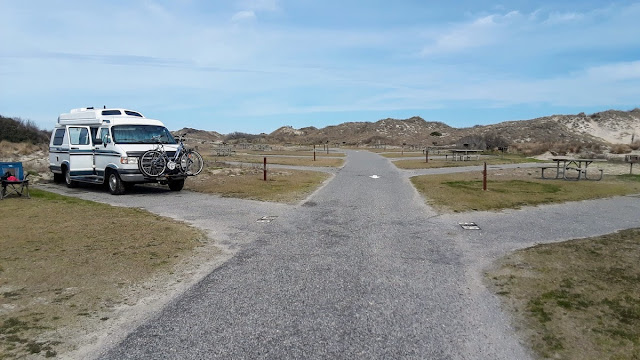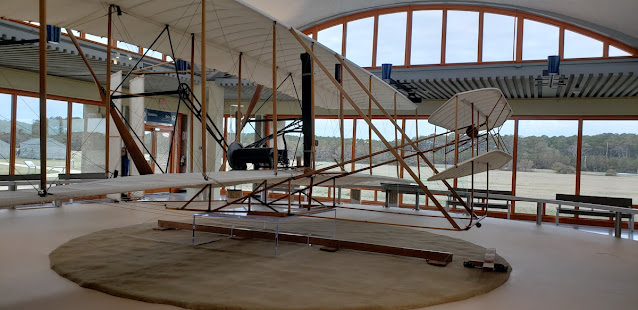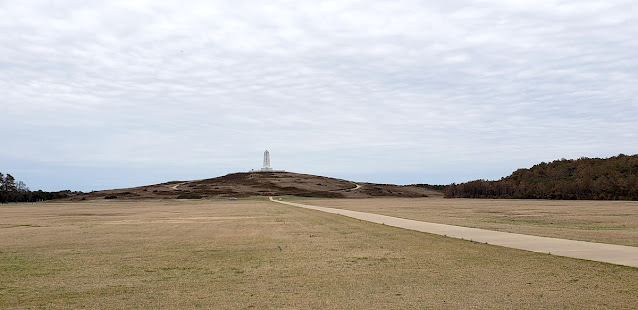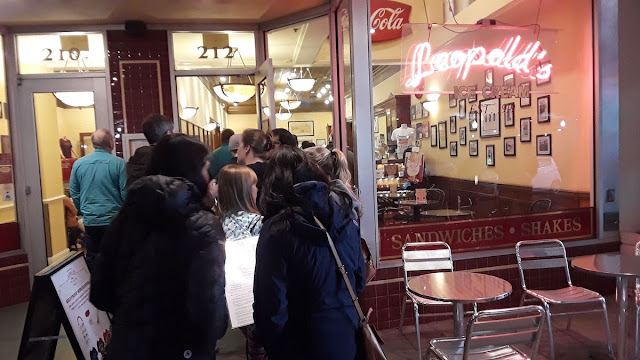Virginia & Going Home
March 7-17, 2020
 |
| A toast to celebrate our successful and eventful Winter Road Trip 2020. |
Our niece’s March 7 wedding in Virginia Beach was the inspiration for our Winter 2020 cross-country road trip. We left Juneau on January 7, 2020, and picked up our camper van stored in Sacramento. All our adventures from California to Virginia naturally fell into place—a family visit in Palm Springs, a college roommate reunion in Las Vegas, a family reunion in Mississippi, and several wonderful visits with longtime friends.
 |
| We left Juneau on January 7 and drove across the country in two months. |
A road trip like this required planning, but we couldn’t have anticipated every scenario. (See the Blog Archive for posts of previous legs of our journey.)
The Wedding
On March 6, we left the Outer Banks National Seashore in North Carolina and drove north to Virginia Beach. We looked forward to visiting family and friends as well as celebrating my niece’s wedding.
 |
| We visited with many dogs on this trip. My niece's dogs were snugglers. |
When relatives live across the United States, a wedding also serves as a de facto family reunion. We stayed in Virginia Beach three nights and enjoyed Sunday dinner with my dearest friend since seventh grade before departing for my mother’s house in Midlothian.
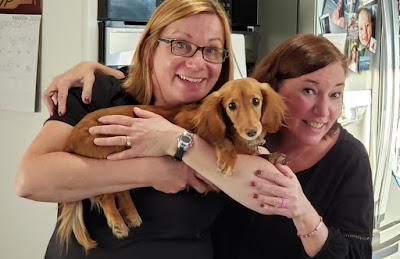 |
| My friend Bonnie's dog, Willow, was lovable too. |
The plan was for me to visit my mother and step-father for three weeks before flying to Maine to see my son during his spring break. Roger was to fly to the West Coast ahead of me to attend a meeting and visit his children. That was the plan as of March 9. Two days later, everything changed.
Coronavirus, cancellations, and changes
COVID-19 was spreading fast, and events across the country were being canceled. As of March 9, the United States had experienced 26 deaths caused by COVID-19, and there’d been 4,000 deaths worldwide. (See Notes 1) By March 11, Washington state, San Francisco, and Oakland announced size limits on large gatherings.
 |
| Good morning from Midlothian, Virginia! Our final destination. |
Our concerns quickly shifted from, “Do we cancel our plans?” to “Can we get home before the whole country shuts down?” As chairman of the planning committee, Roger had been in regular contact with meeting planners. After much back and forth, they decided to cancel their meeting.
 |
| Feeling spoiled at Mom's house. |
I spent two days agonizing over what to do. I would make up my mind to go to Maine in one moment only to change it a few hours later. I went back and forth several times until bedtime on the evening of Thursday, March 12. Final decision. I would go home with Roger. By then, the NBA, NHL, and NSL had all suspended their seasons. The NCAA canceled championship basketball tournaments, followed by Major League Baseball canceling spring training games. What seemed like a choice just two days earlier—should I stay or should I go?— became an imperative—we must get home to Juneau, together, as soon as possible.
 |
| I inherited my love of food and cooking from my mother. She treated us to our favorites. |
We spent most of the day on Friday, March 13, (Yes, Friday the 13th!) online, changing our flight plans. Most airlines waived rescheduling fees, but we had to reschedule all our flights online. The airlines would only accept phone calls from people in emergency situations or whose flights were scheduled in the next 48 hours. One of the biggest mistakes we made was rerouting our flights through Boston. Why I thought we had to fly via Boston, I can’t tell you. We could have flown to Seattle directly from D.C.
After securing new flight plans, we spent the rest of the weekend preparing the van for storage. Storing the van in Virginia had been our plan all along. We wanted to stage it for our next few trips exploring the East Coast. We found a storage yard less than five minutes from my mother’s house in Midlothian. We left the sleeping bags with my mother, who would take them to the cleaner. I also left her with several boxes to ship to Juneau. We put the bikes and the bike rack inside the van and placed an open container of mothballs inside to ward off critters looking for a new home.
 |
| Virginia was the end of the road for this trip, and the van went into storage. |
Saying goodbye to the van was bittersweet. Our van is like our home. It’s hard to say goodbye when you don’t know when you’ll see each other again.
Flying Home
We flew out of Richmond to Boston via Washington, D.C., on Monday, March 16, wiping every surface with Clorox wipes we swiped from the van.
 |
Carlsbad, the Year of the Rat mascot we found in Carlsbad, New Mexico, is ready to fly to his new home in Juneau. |
Our flight from Boston to Seattle got delayed, delayed, delayed, then finally canceled. It seemed like the only people at the airport were our cohort of passengers trying to get to the West Coast. I felt sad for the many college students traveling home for spring break. Schools told them to take everything with them as if they would not be returning. Boston is home to several music schools. Many of the students carried instruments in addition to their large suitcases full of their belongings. College classes and K-12 schools across the country would move online or be canceled for the rest of the semester.
Earlier in the day, when one of the Boston delays would make us miss our connection in Seattle to Juneau, we had to stand in a long line to rebook our next flight. I volunteered. Some people wore masks. My step-father had given us masks before we left the house that morning, but we did not wear them. In retrospect, it was probably a dumber mistake than flying through Boston. I don’t know why we didn’t wear them. I guess we were still naive about the seriousness of the situation. But in fairness, the public messaging at the time was that a mask would only help those already infected from spreading the virus and would not protect people from being infected. Public messaging in the early days of the pandemic also discouraged using N-95 masks because healthcare facilities were experiencing an N-95 mask shortage. The N-95 mask was believed to offer the best protection, and homemade cloth masks had not caught on yet.
 |
| We’ve never seen so few people at Logan International Airport in Boston. |
Eventually, Alaska Airlines canceled our flight to Seattle at around 10:00 p.m., and we had to stand in another long line to rebook. We left the gate area with some of the other passengers and got in line at the Alaska Airlines desk downstairs. While waiting in that line, I overheard a woman on the phone. She was desperate to help her daughter get home from Ecuador.
She was not part of our group. She came to the airport, thinking she could get answers if she was there in person. Her daughter had been visiting the Galapagos Islands when the Ecuadorian government abruptly canceled all flights in and out of Ecuador. The woman was calling every U.S. government and airline official she could think of with no success. I heard her say to a government official on the phone, “You’re just reading to me what’s on the website. I already read that myself. That information is not up to date. They’re not letting any flights out. Is there anything else you can do?”
By now, many of us felt helpless with the situation.
 |
We had time to appreciate Chris Williams’s “Seascape” installation during our many hours of waiting at Logan's Terminal B. |
Alaska Airlines provided hotel and food vouchers for all the passengers on our canceled flight. They sent an email link with a list of options, and we chose a hotel—a nice hotel in Chelsea. Then we had to retrieve all our luggage and schlep it to a shuttle bus to the hotel. Again, these poor college students with all their luggage. While in line (again) at the hotel, a young man ahead of us had large suitcases and loads of ski gear. He was a competitive collegiate skier, and the rest of the season had been canceled. He was trying to get home to Anchorage. When he got his turn at the check-in counter, he learned he had gone to the wrong hotel. Poor kid. He had to drag everything back outside and find a ride to his hotel.
Around midnight, we checked in, and I mentioned to the man at the front desk that I was born in the old Naval hospital in Chelsea. The building is not a Naval hospital anymore, but the hotel clerk said, “Oh, yeah, that’s just around the corner. Welcome home!”
 |
To curb the spread of COVID-19, dine-in restaurants and most stores at the San Francisco airport had already closed by the time we arrived on March 17, 2020. |
By the time our heads hit the pillows, we had already received an automated text from Alaska Airlines. They changed our new flight schedule for the next morning. By morning, Alaska Airlines had sent another text message with a different schedule. The message also said we should see a customer service agent when we arrived at the airport. These text messages and flight changes were automated and made no sense. They had us departing Seattle before we had even arrived there. Knowing we’d have to wait in another long line, we got on the 5 a.m. shuttle back to the airport.
 |
The reality of the pandemic continued to settle in as we traveled two whole days to get home. |
This was my third time standing in a long line for over an hour. Some people tried to jump the line by starting a new queue in the first class or special assistance line. The rest of us who had gotten out of bed extra early and had been in line for a long time already wasn’t having it. One young guy who tried to cut in line got called out and replied, “F*ck it. Who has time for this?” and left the area.
 |
Roger, standing under Janet Echelman’s “Every Beating Second” at SFO. “The title, ‘Every Beating Second,’ referring to a line by beat poet Allen Ginsberg, represents the artist’s interest in heightening awareness of the present moment: live in the physical world moment to moment I must put down every recurring thought-- stop every beating second (11-16)" |
Who has time for this? Good question. Who has time for this? We do. We have time. Some of us have time. When I think about people who genuinely suffer—people whose lives have already been cut short by this disease or other illnesses, war, famine, or violence—I tell myself, thank God I have time for this. I have time. I am so lucky that I have time.
 |
Aboard our Alaska Airlines flight ascending over the Bay Area. |
The mood at the airport was solemn. No one wanted to be there. We all wanted to get home. No one was just starting a vacation, and no one was happy to be traveling. It was an unprecedented time in our lives. We followed social norms and saved spots in line when another passenger had to use the bathroom. We were all going through the same thing. “We’re all in this together” was an encouraging phrase we would hear over the next several months. Yet under our stoic shells, we wore layers of frustration and fear. Ultimately our travels took us through several hot zones over two days traveling from Richmond to Washington D. C. to Boston to San Francisco to Seattle and finally to Juneau.
 |
Finally, getting closer to home. A good feeling. |
There's no place like home.
After finally arriving home late on the evening of March 17, we quarantined for two weeks. Our refrigerator was empty, and family and friends graciously shopped and delivered groceries. We gradually settled into the new norm—curbside pick up, wearing masks in public, and eventually, socializing only within our small social bubble. Fortunately, the weather was improving, and the golf course opened. I started hiking regularly and planted a garden. We were relieved to be home, healthy, and together.
 |
Hike to Dupont - our preferred method of social distancing. |
We stayed in Juneau for the summer, deciding not to make our annual pilgrimage to Pelican. (See our blog article about our get-away cabin in Pelican, Alaska.) We thought it was best to stay in Juneau and respect and protect our friends in Pelican by not traveling there. Our annual visit to Pelican is usually the highlight of our year, but it was not essential. We certainly missed being in Pelican and questioned our decision but believe it was the right thing to do. Halibut fishing in Juneau was undoubtedly not as productive as in Pelican. However, we caught enough to enjoy fish and chips throughout the winter.
 |
When we need a get-away from staying home, we retreat to the Dawn Treader for a day or two on the water. |
The van and the road call to us now and then, and we have already planned a 2021 fall foliage van trip through New England. Let’s hope there’s a vaccine by then and that travel will be safer.
 |
With my hiking bubble friend, Mary, on top of Eaglecrest Ski Area, overlooking downtown Juneau. Thank goodness there’s plenty of space for everyone. |
At the time of publication, COVID-19 cases in the United States were surging to record levels—10.5 million cases and 242,000 deaths. (Source: The New York Times, 11/12/2020) Our thoughts are with the people affected by this terrible illness, especially those who have lost loved ones and healthcare workers treating patients. We will continue to do our part to make the world a safe and healthy place for everyone.
“Lots of things are mysteries. But that doesn’t mean there isn’t an answer to them. It’s just that scientists haven’t found the answer yet.” -- The Curious Incident of the Dog in the Night by Mark Haddon
Thank you, readers, for following our cross-country journey. We enjoy sharing our experiences with you and sparking your interest in some of the places we visited. Please leave comments below and sign up to receive notifications when we post new articles. You can also email us at eastmeetswestme2ak@gmail.com.
Road Trip 2020 by the Numbers
- 5,411 miles
- 71 days
- 43 friends & family visited (not including family members of people we visited or other guests at reunion and wedding.)
- 12 states
- 10 dogs
- 6 national parks
- 5 golf courses
- 2 bikes
- 2 cats
- 1 family reunion
- 1 wedding
- 1 breakdown
- 1 pandemic
- 1 Walmart haircut special
NOTES
1 (Wikipedia, per CNN “Coronavirus death toll passes 4,000 worldwide”. CNN. March 10, 2020. Retrieved March 10, 2020.)
2 (“Timeline of how the COVID-19 pandemic has impacted the 2020 Major League Baseball season”, by Dayn Perry, Katherine Acquavella & R.J. Anderson July 29, 2020, at 10:44 a.m. ET)
#vanlife #crosscountryroadtrip #virginia #COVID19 #me2ak #backeast #ontheroad



